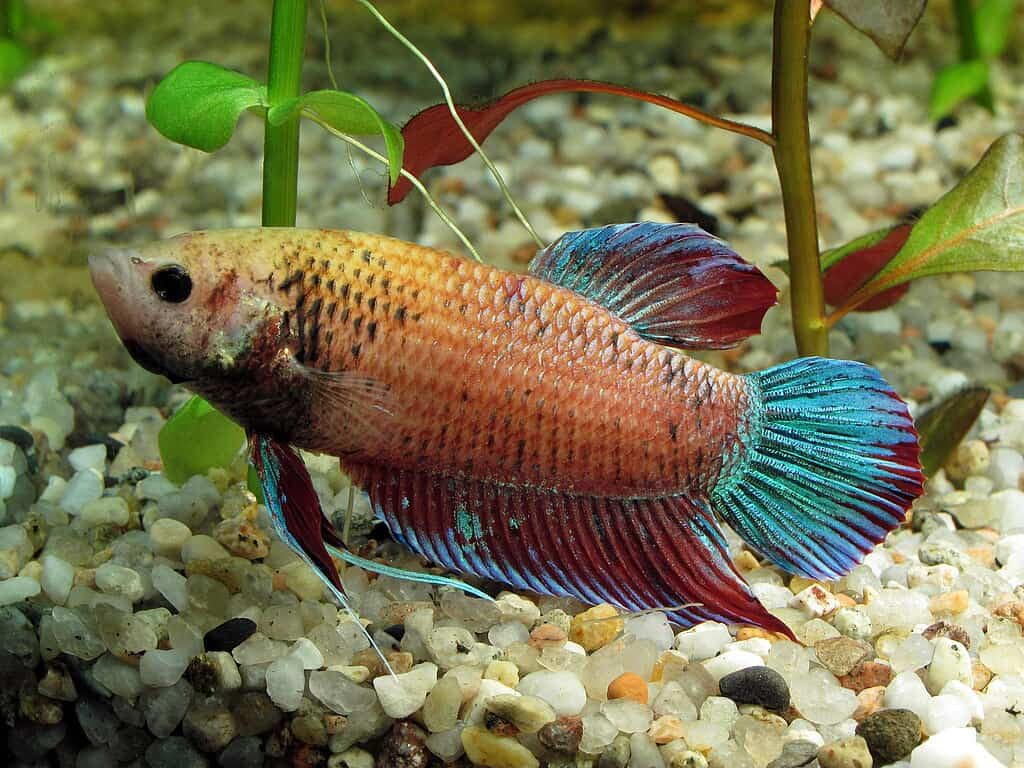Understanding fish behavior is crucial for creating a harmonious aquarium environment. Many species naturally form schools in the wild—a behavior that serves multiple purposes including protection from predators, improved foraging efficiency, and reproductive advantages. These schooling tendencies translate well to home aquariums, where they not only fulfill the fish’s natural instincts but also create visually stunning displays of synchronized movement.
However, not all fish share this social nature. Some species are territorial, aggressive, or simply prefer solitude. Keeping these fish in groups can lead to stress, injury, or even death. In this article, we’ll explore ten popular fish species that thrive when kept in schools and three species that must be kept alone, helping you make informed decisions about your aquatic community.
Neon Tetras The Classic Schooling Fish
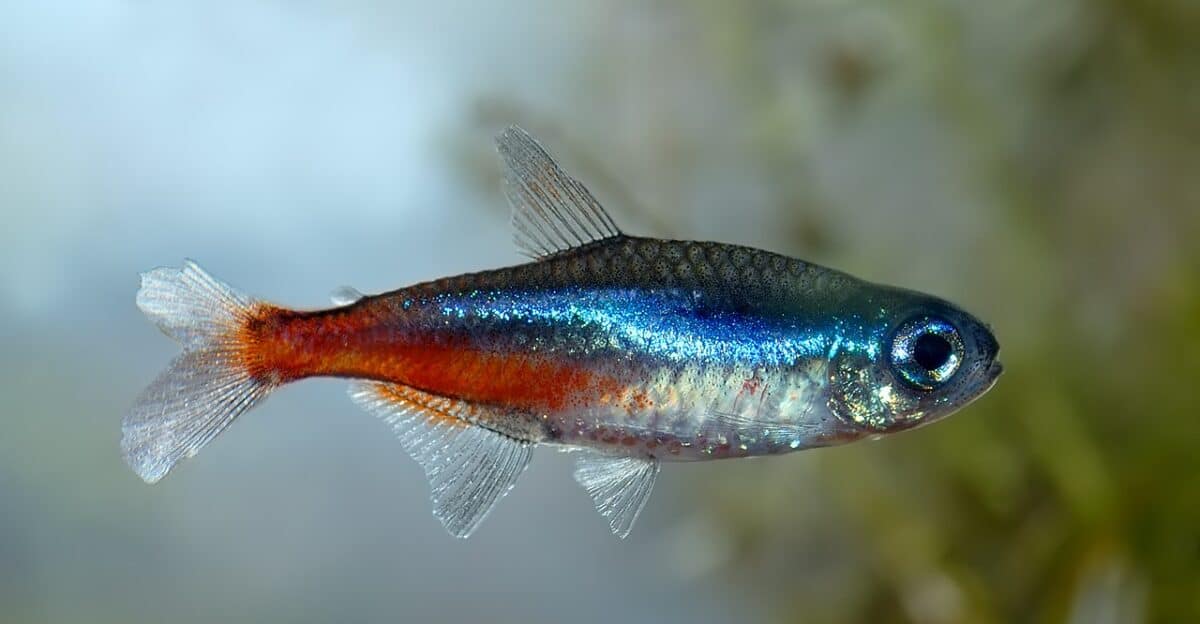
Neon Tetras (Paracheirodon innesi) are perhaps the most iconic schooling fish in the aquarium hobby. These small, vibrant fish display a striking blue-green horizontal stripe above a bright red band on their lower body. Originating from the blackwater streams of the Amazon basin, Neon Tetras are most comfortable when kept in groups of at least six, though groups of 10-15 create the most impressive visual display and provide optimal security for these naturally shy fish.
In larger schools, Neon Tetras exhibit more natural behaviors, including synchronized swimming patterns that showcase their iridescent colors. They’re peaceful community fish that reach only about 1.5 inches in length, making them suitable for aquariums as small as 10 gallons, though larger tanks allow for more impressive schooling behavior. Their schooling instinct is so strong that keeping them in insufficient numbers can lead to stress, weakened immune systems, and shortened lifespans.
Rummy Nose Tetras The Synchronized Swimmers
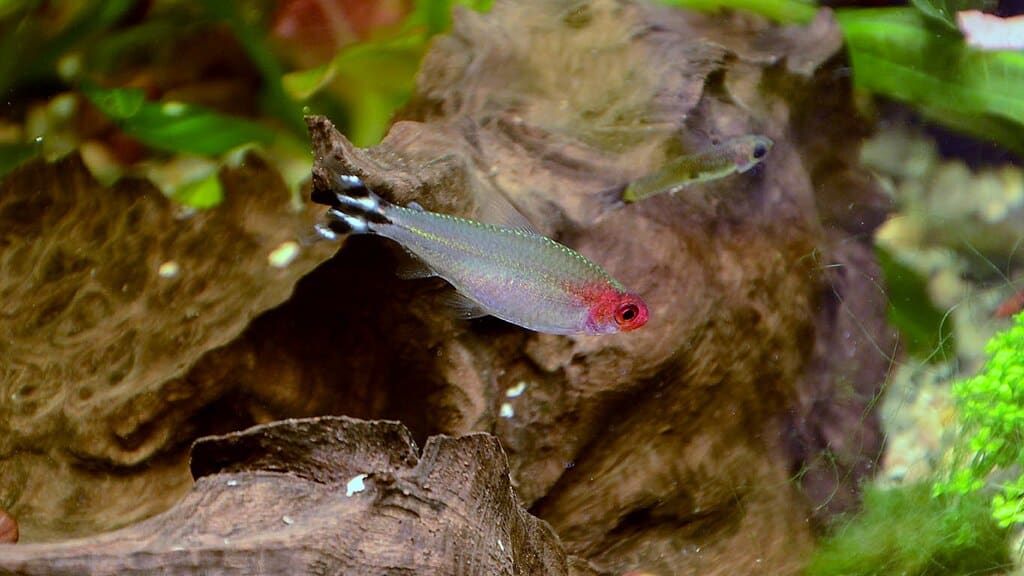
Rummy Nose Tetras (Hemigrammus rhodostomus) are renowned for their tight schooling formation and synchronized swimming, making them among the most cohesive schooling fish available to hobbyists. Their name comes from their distinctive bright red “nose” which, along with their black and white striped tail fin, creates a striking appearance. These South American natives thrive in groups of six or more, though schools of 10-12 showcase their natural behaviors best.
What makes Rummy Nose Tetras particularly special is their tendency to swim in perfect unison, turning and changing direction as if they share a single mind. This behavior not only creates a mesmerizing display but also serves as an excellent indicator of water quality—their bright red faces can pale when water parameters deteriorate. Reaching about 2 inches in length, they require at least a 20-gallon aquarium to accommodate their active swimming style and schooling behavior.
Cardinal Tetras The Neon’s More Colorful Cousin
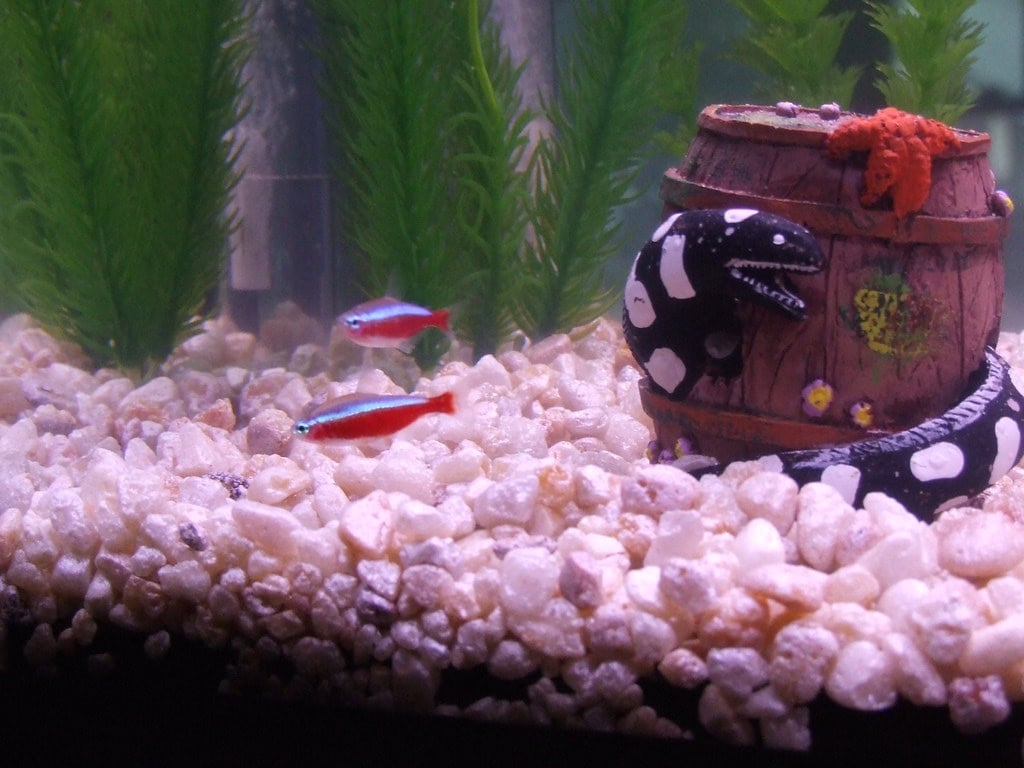
Cardinal Tetras (Paracheirodon axelrodi) are often confused with Neon Tetras but can be distinguished by their full-length red stripe that extends from head to tail. These stunning fish come from the Rio Negro basin in South America and grow slightly larger than Neons, reaching up to 2 inches. Cardinals are quintessential schooling fish that display their most natural behavior and vibrant colors when kept in groups of 8-12 or more.
In sufficiently large schools, Cardinal Tetras create a spectacular display of color as they move through the aquarium in unison. They prefer dimly lit tanks with plenty of plants and hiding places, mimicking their blackwater habitats. Though slightly more demanding in terms of water parameters than Neons, they’re generally hardier once acclimated. Their schooling instinct is powerful—in the wild, they form enormous schools for protection against the numerous predators in their native waters.
Harlequin Rasboras The Peaceful Schoolers
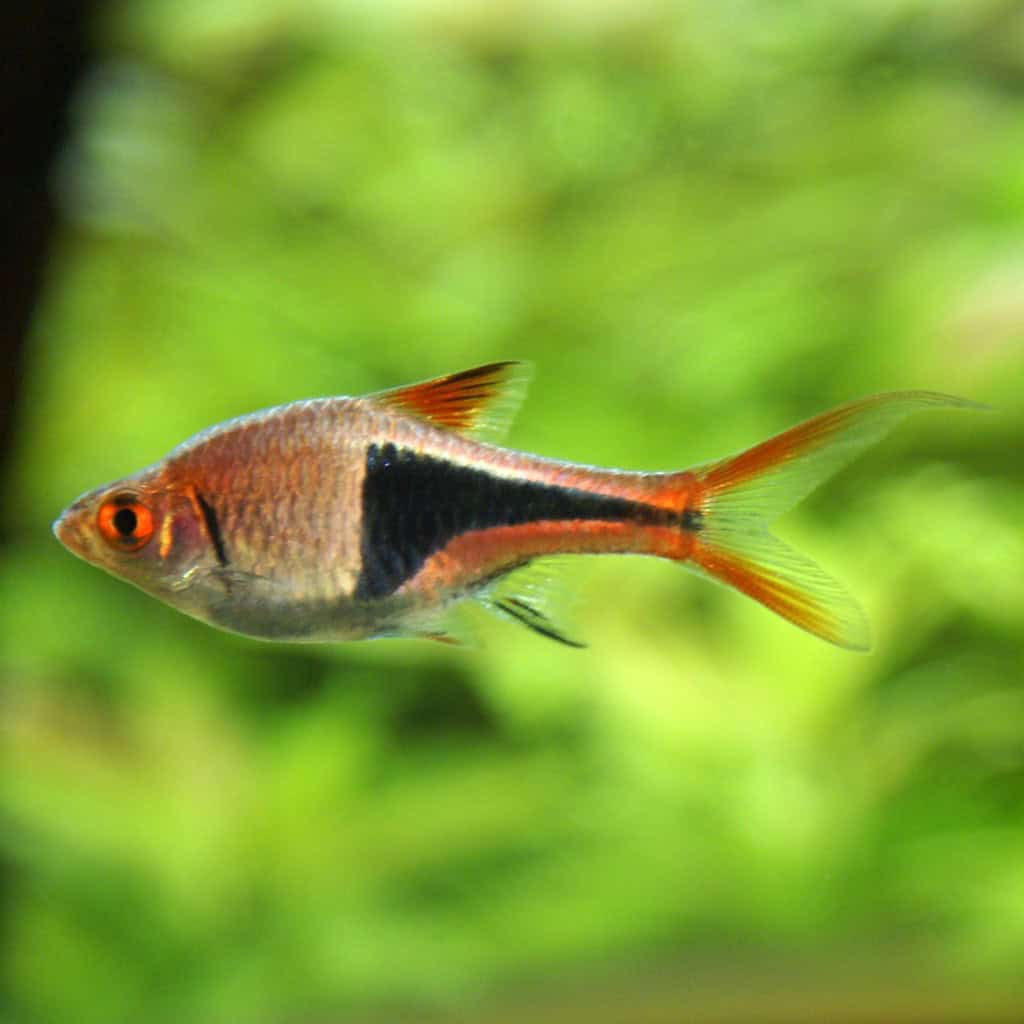
Harlequin Rasboras (Trigonostigma heteromorpha) are peaceful, active schooling fish recognized by their distinctive triangular black patch on an orange-copper body. Native to Southeast Asia, these fish reach about 2 inches in length and are ideal for community tanks due to their non-aggressive nature. They thrive in groups of 6-8, though larger schools of 10-12 create more impressive displays and provide greater security for the fish.
Unlike some schooling species that may occasionally break formation, Harlequin Rasboras tend to stay close together most of the time. They’re particularly active during feeding, when their schooling behavior intensifies. These adaptable fish are excellent for beginners, as they’re hardy, disease-resistant, and tolerant of a range of water conditions. Their preference for the middle water column makes them ideal companions for bottom-dwelling species and those that prefer the upper regions of the tank.
Zebra Danios The Energetic Schoolers
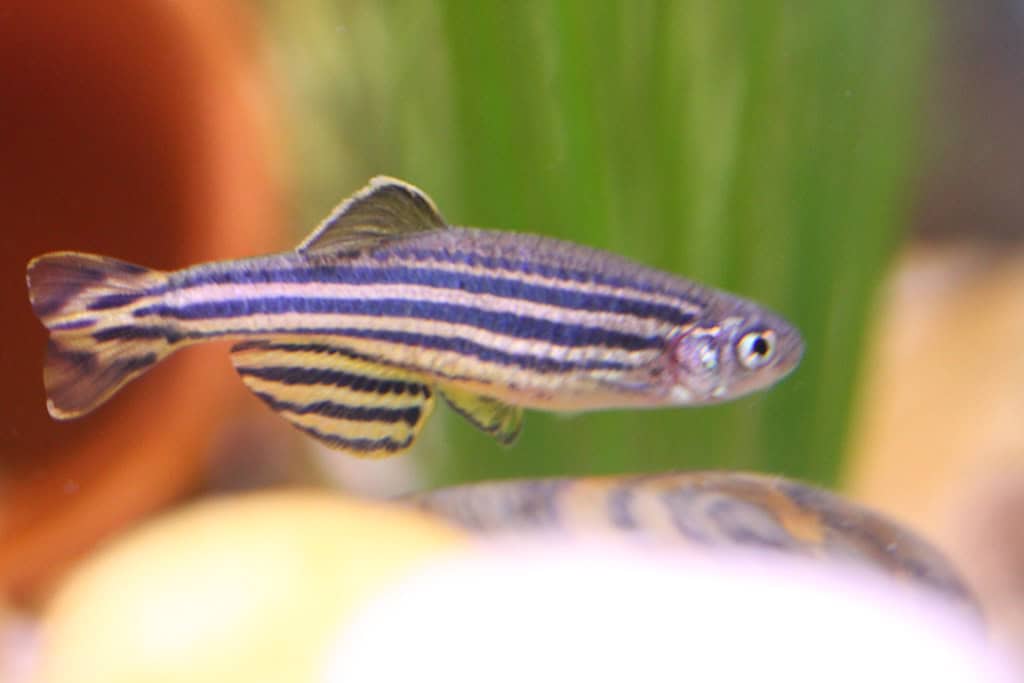
Zebra Danios (Danio rerio) are among the hardiest and most active schooling fish available in the hobby. Recognizable by their horizontal blue and silver stripes, these fish are native to the streams and rivers of India and Bangladesh. Growing to about 2 inches, Zebra Danios are constant swimmers that require groups of at least 6-8 individuals to feel secure and display their natural behaviors, though schools of 10 or more create the most dynamic displays.
Their energetic nature makes Zebra Danios excellent fish for cycling new aquariums, as they can withstand fluctuating water conditions better than most species. In proper schools, they dart around the upper and middle portions of the tank in tight formation, rarely resting. This constant movement not only creates visual interest but helps prevent algae buildup by disrupting water surfaces. Their hardiness, affordability, and striking appearance have made them popular both as pets and as important model organisms in scientific research.
Corydoras Catfish The Social Bottom Dwellers
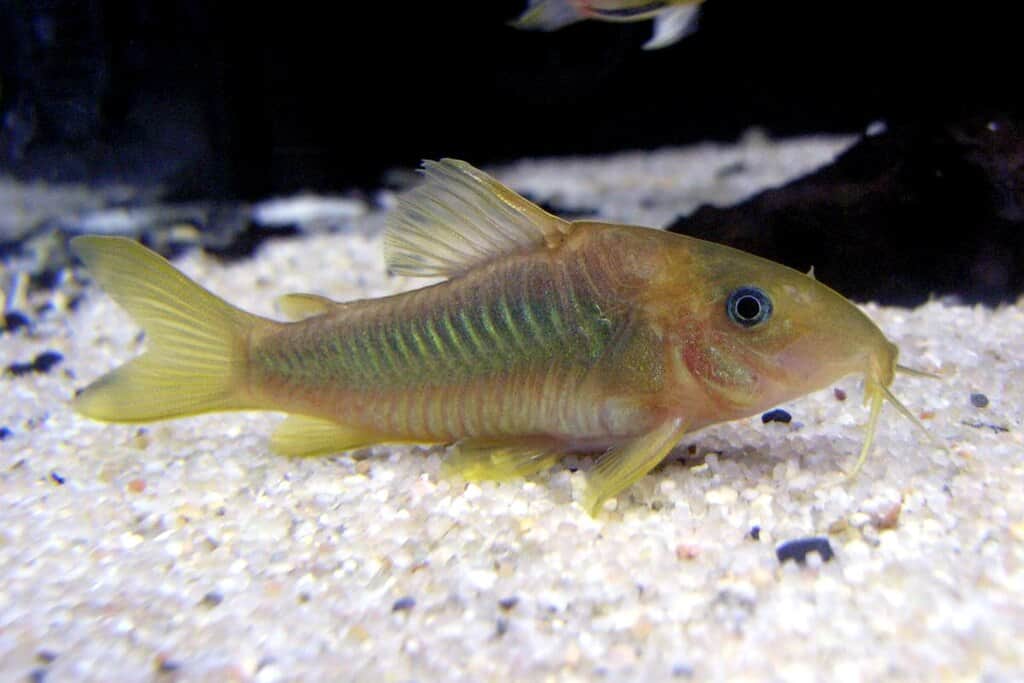
Corydoras catfish represent one of the few bottom-dwelling fish groups that exhibit strong schooling behaviors. These armored catfish, with over 170 species in the genus, originate from South American waters and typically grow between 1-4 inches depending on the species. Popular varieties include Bronze Corydoras (C. aeneus), Panda Corydoras (C. panda), and Pygmy Corydoras (C. pygmaeus). They thrive in groups of 6 or more, with larger schools allowing for more natural behavior patterns.
Unlike some schooling fish that remain in tight formation, Corydoras often spread out while foraging along the substrate but quickly regroup when startled or during rest periods. Their social nature is evident as they pile together in corners or among plants when sleeping. These peaceful catfish serve an important function in aquariums by scavenging uneaten food and detritus, though they should still receive dedicated feeding of sinking pellets or tablets. Their barbels are used to sift through substrate, making sand the preferred bottom material to prevent injury to these sensitive organs.
Cherry Barbs The Colorful Schoolers
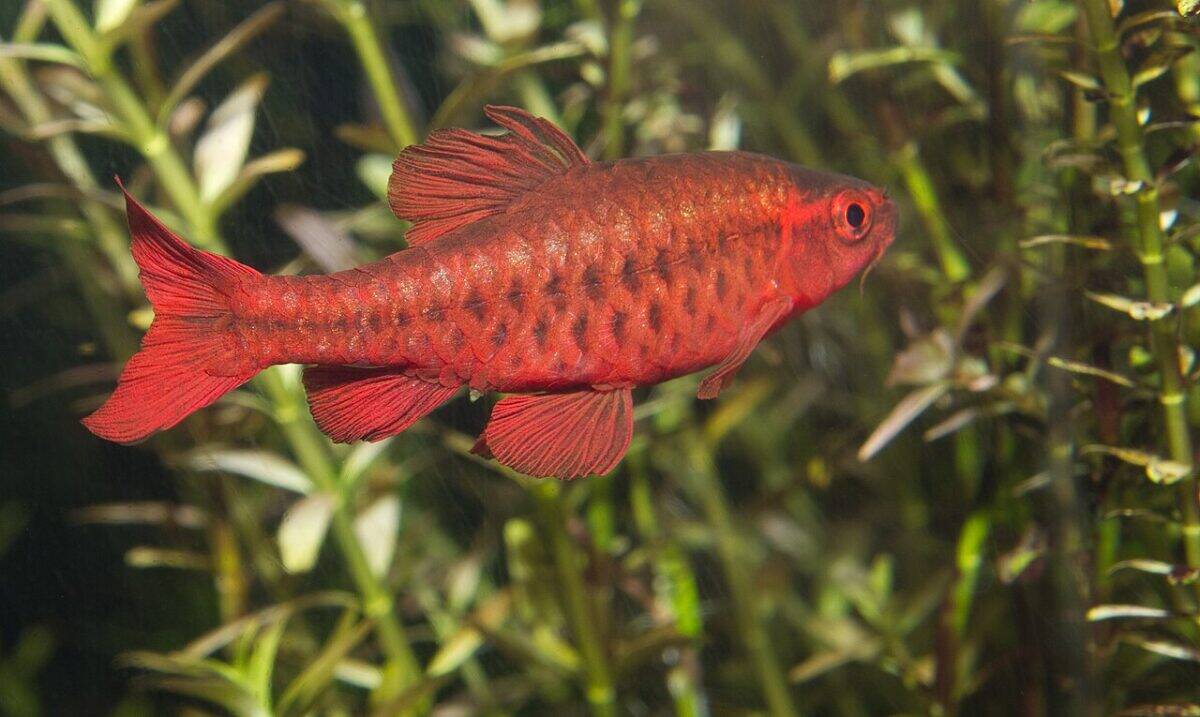
Cherry Barbs (Puntius titteya) are popular schooling fish known for the males’ brilliant red coloration, which intensifies when they’re kept in proper social groups. Native to Sri Lanka, these fish reach about 2 inches in length and display their best colors and most natural behaviors when kept in groups of 6-8 or more. In smaller numbers, they often become shy and their colors may fade significantly.
Unlike some more hyperactive schooling species, Cherry Barbs maintain a moderate activity level, making them suitable for community tanks with various temperaments. Males occasionally display mild territorial behavior toward each other, but this aggression is dispersed in proper schools and rarely causes harm. They’re adaptable to various water parameters and are particularly striking in planted aquariums where their red coloration stands out against green foliage. Cherry Barbs are omnivorous and readily accept most foods, making them an excellent choice for beginners wanting to keep schooling fish.
White Cloud Mountain Minnows The Cool Water Schoolers
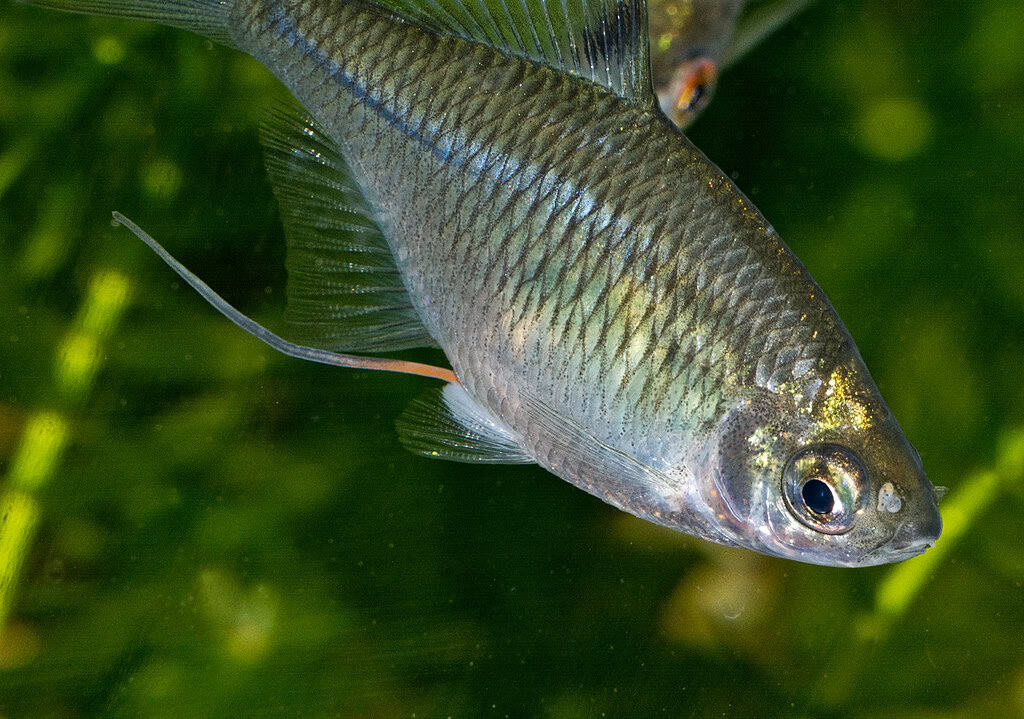
White Cloud Mountain Minnows (Tanichthys albonubes) are sometimes called “poor man’s neon tetras” due to their similar size and schooling behavior, but they offer unique advantages. These fish, native to China, are among the few tropical-looking species that thrive in unheated tanks with temperatures between 64-72°F. Growing to about 1.5 inches, they display red-orange fins and a shimmering horizontal stripe on a silvery body. They should be kept in groups of at least 8-10 individuals to encourage natural schooling behavior.
Their ability to thrive in cooler water makes White Cloud Mountain Minnows ideal for temperate aquariums or outdoor ponds in mild climates. In proper schools, they become more active and display more intense coloration. Despite being listed as critically endangered in the wild due to habitat destruction, they breed readily in captivity, making them sustainable for the aquarium trade. Their peaceful nature, hardiness, and striking appearance when schooling make them excellent fish for beginners and experienced aquarists alike.
Emperor Tetras The Regal Schoolers
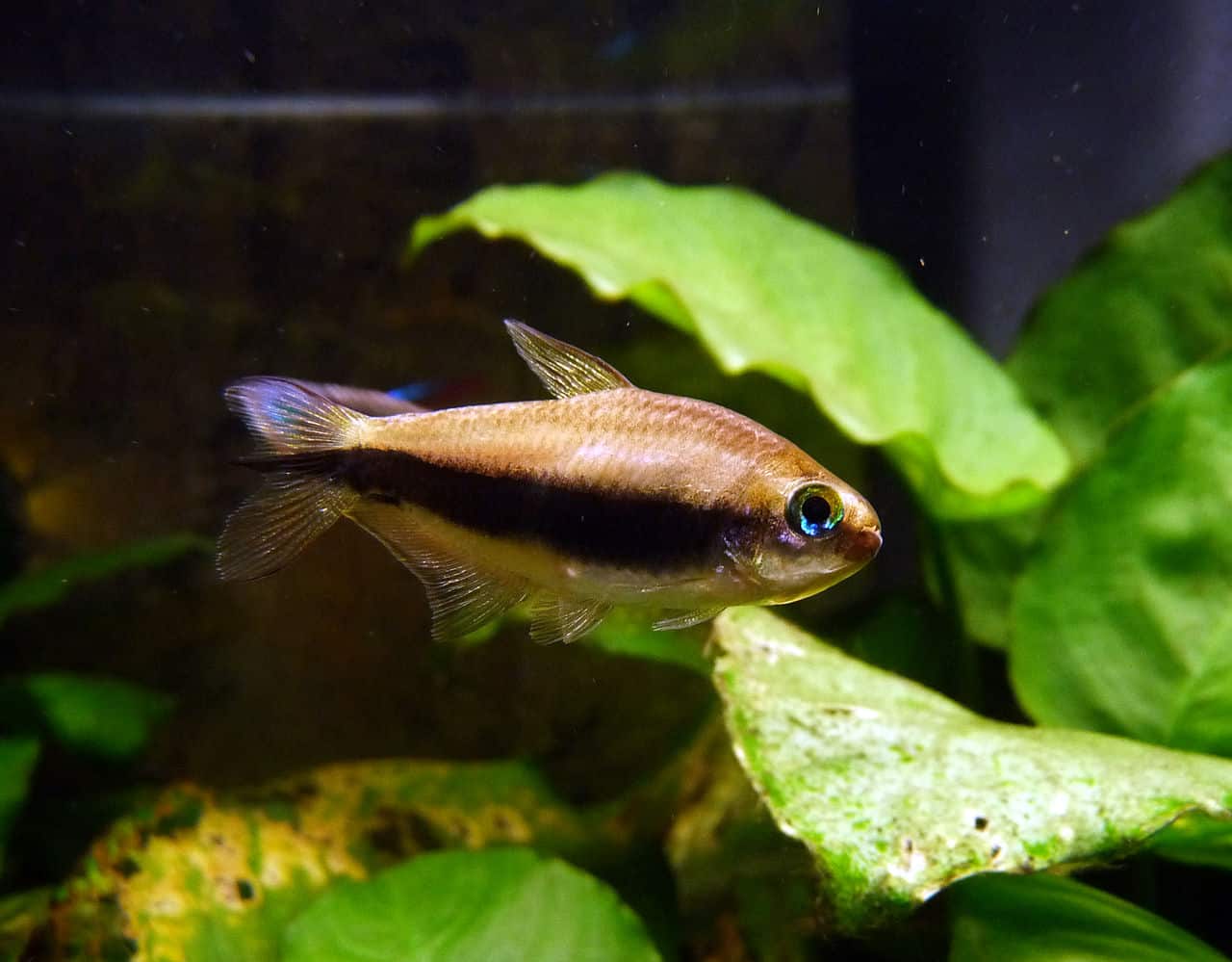
Emperor Tetras (Nematobrycon palmeri) stand out among schooling fish with their distinctive appearance and behavior. Males display elongated fins, iridescent blue-purple bodies, and striking yellow eyes that give them a regal appearance. Native to Colombia, these tetras grow to about 2 inches and exhibit their most natural behaviors in groups of 6-8 or more, though they don’t school as tightly as some other tetra species.
What makes Emperor Tetras particularly interesting is their social hierarchy within the school. Males establish a pecking order but rarely cause serious harm to each other when kept in appropriate numbers. In proper schools, their colors intensify and males frequently display to each other and to females. They prefer slightly acidic, soft water and subdued lighting with plenty of plants. Unlike many schooling species that occupy the middle water column, Emperors utilize all levels of the aquarium, creating visual interest throughout the tank.
Leopard Danios The Spotted Schoolers

Leopard Danios (Danio rerio var. frankei), a spotted variant of the Zebra Danio, share the same energetic schooling behavior as their striped cousins but with a distinctive spotted pattern that creates a different visual effect when they school. Reaching about 2 inches in length, these fish are native to South Asia and should be kept in groups of at least 6-8, though schools of 10 or more create the most impressive displays and ensure the fish feel secure.
Like Zebra Danios, Leopard Danios are incredibly hardy and active, making them suitable for beginners and for cycling new aquariums. Their constant movement throughout the upper and middle water columns provides excellent visual interest and helps prevent water stagnation. In proper schools, they display fascinating synchronized swimming patterns, especially during feeding time. Their adaptability to various water conditions, coupled with their peaceful nature, makes them compatible with many community tank inhabitants.
Bettas The Solitary Warriors
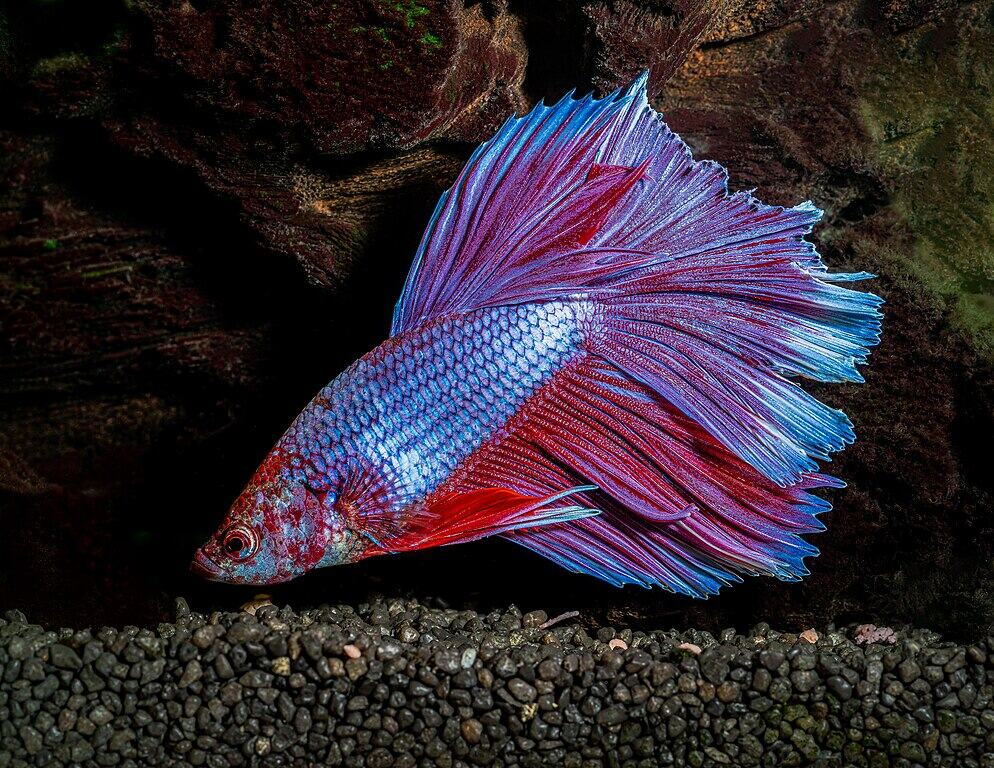
Siamese Fighting Fish (Betta splendens) are among the most misunderstood aquarium fish. While females can sometimes coexist in carefully managed “sororities,” male bettas must be kept alone or serious injury and death will result. This solitary nature stems from their evolution in shallow rice paddies and slow-moving waters in Thailand, where they developed aggressive territorial behaviors. Male bettas flare their gills, spread their fins, and fight viciously when encountering other males—behavior that gave rise to their use in fish fighting in their native region.
Despite needing to be kept alone, bettas thrive with proper care. They require heated tanks of at least 5 gallons (contrary to the popular myth that they can live in small bowls), filtration with gentle flow, and regular water changes. Their labyrinth organ allows them to breathe atmospheric air, but this doesn’t eliminate their need for clean, warm water. When properly housed, solo bettas develop interactive relationships with their caretakers, recognizing them and often performing “dances” at feeding time. They can be kept with certain community fish in larger tanks, but never with other bettas or fish with flowing fins that might trigger aggression.
Oscar Cichlids The Territorial Giants
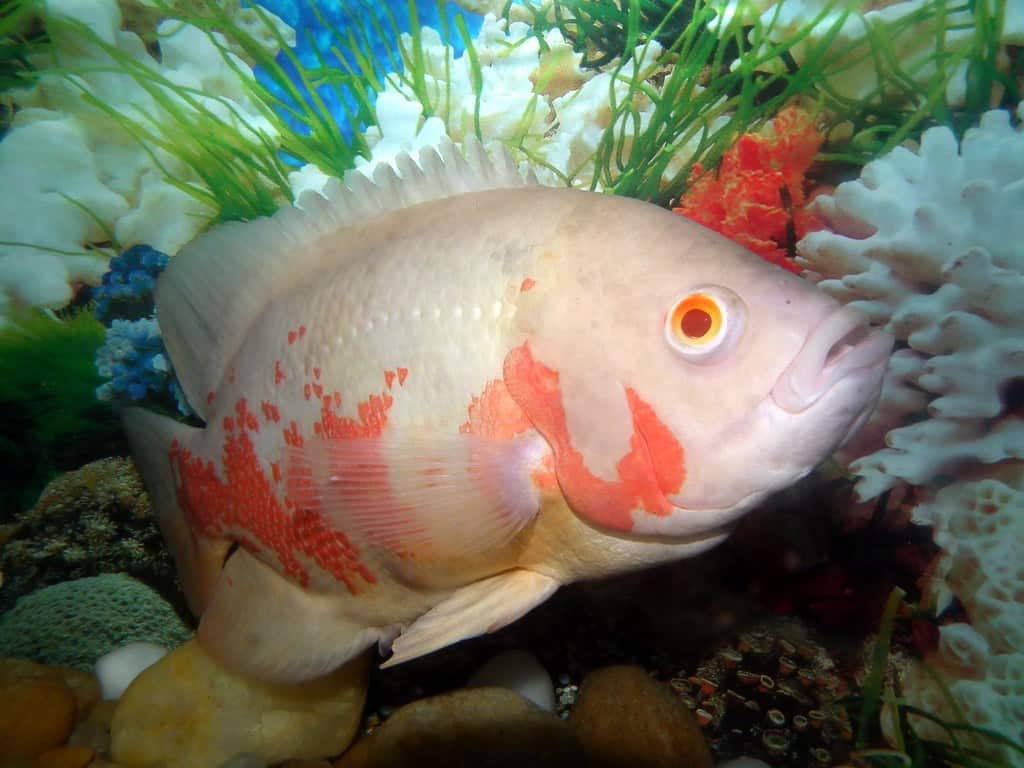
Oscar Cichlids (Astronotus ocellatus) are intelligent, personable fish that bond strongly with their owners but must typically be kept alone or in carefully selected pairs. Native to the Amazon basin, these South American cichlids can grow to 12-14 inches in captivity and live 10-15 years with proper care. Their territorial nature becomes increasingly pronounced as they mature, leading to aggression toward tankmates, especially those of similar size or appearance.
Attempts to keep multiple oscars often result in bullying, stress, and injury unless the aquarium is extremely large (150+ gallons) with carefully designed territories. Their intelligence—comparable to that of a dog in some respects—means they recognize their owners, can be hand-fed, and even learn simple tricks. This same intelligence leads to boredom in improperly furnished tanks, resulting in destructive behavior like rearranging decorations and uprooting plants. While they can sometimes coexist with much larger or smaller fish that don’t compete for territory, most oscar enthusiasts find that these charismatic cichlids do best as the sole centerpiece of their aquarium.
Red-Tailed Black Sharks The Aggressive Loners
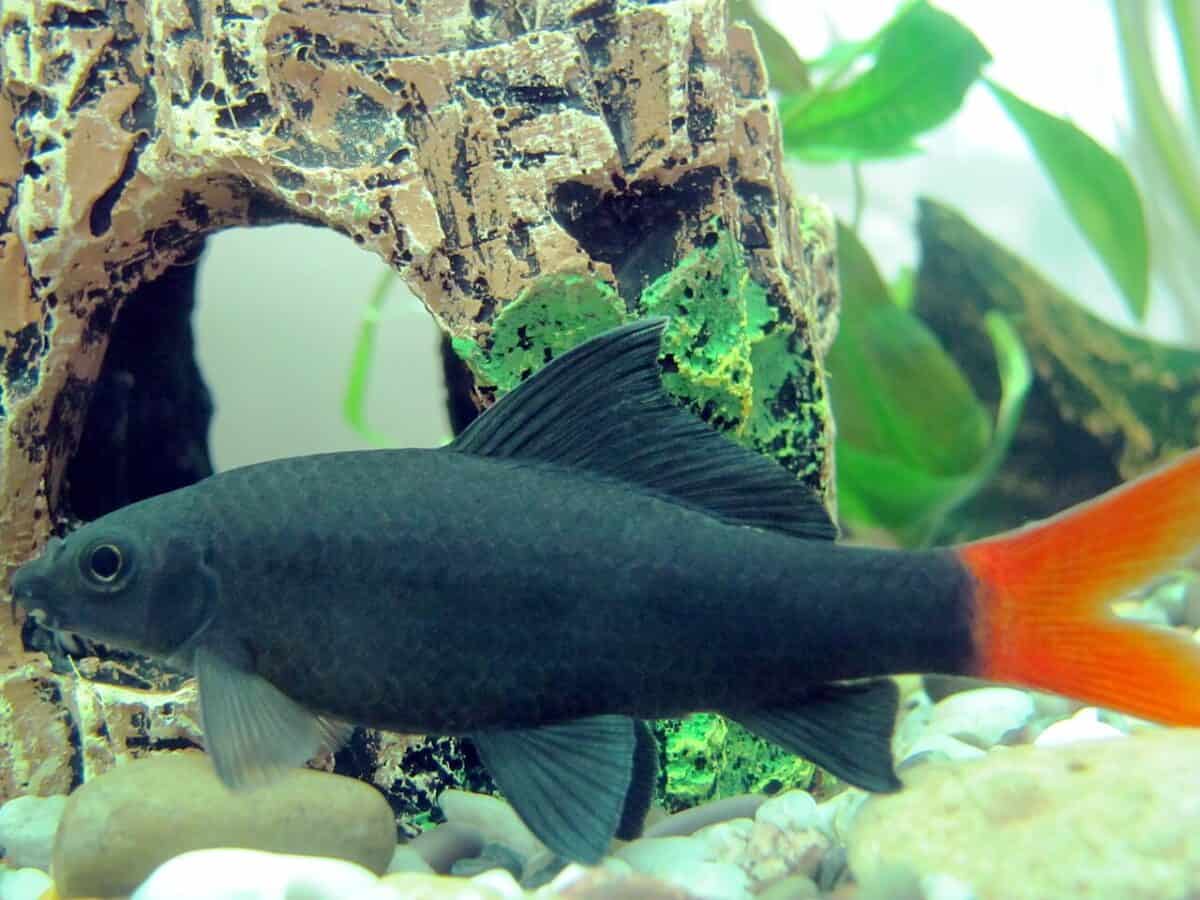
Red-Tailed Black Sharks (Epalzeorhynchos bicolor) are striking fish with jet-black bodies and bright red tails that make them popular choices for aquariums. However, their territorial behavior makes them unsuitable for keeping in groups. Native to Thailand, these cyprinids aren’t true sharks but rather freshwater fish that grow to about 6 inches. They establish and fiercely defend territories, particularly around cave-like structures and along the bottom of the aquarium.
Attempts to keep multiple Red-Tailed Black Sharks invariably lead to aggression, with dominant individuals relentlessly chasing and nipping at subordinates until they succumb to stress or injury. Even in very large aquariums, they rarely coexist peacefully. Interestingly, while they must be the only member of their species in an aquarium, they can sometimes be compatible with different species that occupy different water columns and don’t resemble sharks. Their aggression typically increases as they mature, so peaceful behavior in juvenile specimens often changes dramatically with age. For those wanting these beautiful fish, the rule is simple: one tank, one shark.
Conclusion: Creating the Perfect Environment for Your Fish
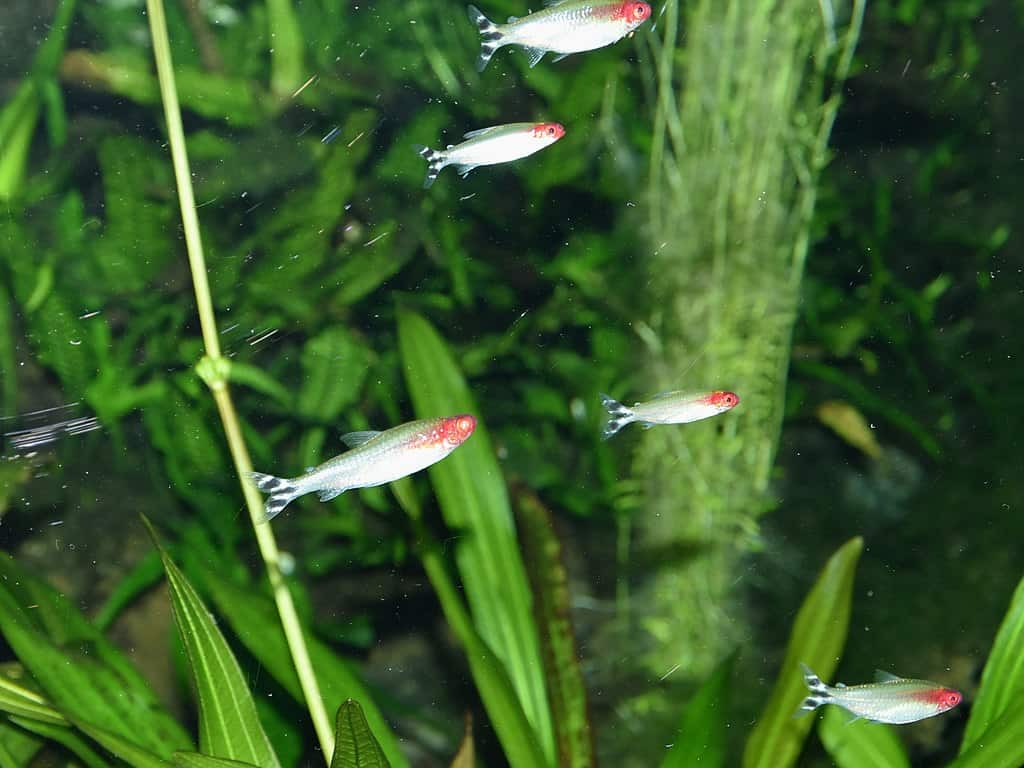
Understanding the social needs of aquarium fish is fundamental to creating a thriving underwater ecosystem. Schooling species not only display more vibrant colors and natural behaviors when kept in appropriate groups, but they also experience less stress, which leads to stronger immune systems and longer lifespans. When selecting schooling fish, ensure your aquarium has sufficient space—a good rule of thumb is at least 2 gallons per inch of small schooling fish, with larger tanks allowing for more impressive schooling behaviors.
For solitary species, providing adequate territory with appropriate hiding places, sightline breaks, and enrichment is essential. These territorial fish often become more interactive with their human caretakers when they don’t need to compete with conspecifics. Whether you choose the mesmerizing synchronized swimming of a school of tetras or the personalized interaction of a solo betta or oscar, respecting the natural social behaviors of your fish will result in a more beautiful, harmonious, and healthy aquarium. Remember that the most successful aquariums aren’t just visually appealing but also honor the biological needs of their inhabitants.
- 13 Baby Animals You Will Only See in Spring - August 26, 2025
- 12 Dog Breeds That Can Face a Leopard in the Wild - August 26, 2025
- 12 Conservation Wins You Did not Know About - August 26, 2025

